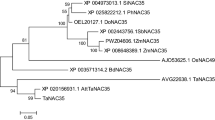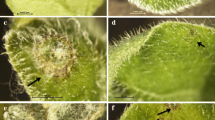Abstract
Using a genomic clone encoding a rice lipid transfer protein, LTP1, we analysed the activity of the 5′ region of the Ltp1 gene in transgenic rice (Oryza sativaL.) during plant development and under pathogen attack. The −1176/+13, −556/+13 and −284/+13 regions of the promoter were fused upstream from the uidA reporter gene and nos 3′ polyadenylation signal, resulting in the pΔ1176Gus, pΔ556Gus and pΔ284Gus constructs which were transferred to rice by microprojectile bombardment. Histochemical and fluorometric GUS assays and in situ detection of uidA transcripts in transgenic homozygous lines harbouring the pΔ1176Gus construct demonstrated that the Ltp1 promoter is preferentially active in aerial vegetative and reproductive organs and that both specificity and level of expression are regulated during organ development. In leaf sheath, GUS activity which is initially strictly localized in the epidermis of growing tissue, becomes restricted to the vascular system in mature tissues. In expanded leaf blade, expression of the uidA gene was restricted to the cutting level suggesting inducibility by wounding. Strong activity was detected in lemma and palea, sterile glumes, and immature anther walls and microspores but not in female reproductive organs. No GUS activity was detected during seed embryo maturation whereas the uidA gene was strongly expressed at early stages of somatic embryogenesis in scutellum tissue. The Ltp1 transcripts were found to strongly accumulate in response to inoculation with the fungal agent of the blast disease, Magnaporthe grisea,in two rice cultivars exhibiting compatible or incompatible host-pathogen interactions. Analysis of pΔ1176Gus leaf samples inoculated with the blast fungus demonstrated that the Ltp1promoter is induced in all cell types of tissues surrounding the lesion and notably in stomata guard cells. In plants harbouring the Ltp1 promoter deletion construct pΔ556Gus, activity was solely detected in the vascular system of mature leaves whereas no uidA gene expression was observed in pΔ284Gus plants. These observations are consistent with the proposed role of LTP1 in strenghtening of structural barriers and organ protection against mechanical disruption and pathogen attack.
Similar content being viewed by others
References
Arondel, V., Vergnolle, C., Cantrel, C. and Kader, J.C. 2000. Lipid transfer proteins are encoded by a small multigene family in Arabidopsis thaliana. Plant Sci. 157: 1–12.
Bäumlein, H., Nagy, I., Villarroel, R., Inzé, D. and Wobus, U. 1992. Cis-analysis of a seed protein gene promoter: the conservative RY repeat CATGCATG within the legumin box is essential for tissue-specific expression of a legumin gene. Plant J. 2: 233–239.
Berhnard, W.R., Thoma, S., Botella J. and Sommerville C. 1991. Isolation of a cDNA clone for spinach lipid transfer protein and evidence that the protein is synthesized by the secretory pathway. Plant Physiol. 95: 164–170.
Bevan, M.W., Barnes, W. and Chilton, M.D. 1983. Structure and transcription of the nopaline synthase gene region of T-DNA. Nucl. Acids Res. 11: 369–385.
Bradford, M. 1976. A rapid and sensitive method for the quantification of microgram quantities of protein utilizing the principle of protein dye binding. Anal. Biochem. 72: 248–254.
Cammue, B.P.A., Thevissen, K., Hendriks, M., Egermont, K., Goderis, I.J., Proost, P., Van Damme, J., Osborn, R.W., Guerbette, F., Kader, J.C. and Broekaert, W.F. 1995. A potent antimicrobial protein from onion seeds showing sequence homology to lipid transfer protein. Plant Physiol. 109: 445–455.
Canevascini, S., Caderas, D., Mandel, T., Fleming, A.J., Dupuis, I. and Kuhlemeier, C. 1996. Tissue-specific expression and promoter analysis of the tobacco Ltp1 gene. Plant Physiol. 112: 513–524.
Chaïr, H., Legavre, T. and Guiderdoni, E. 1996. Transformation of haploid, microspore-derived, cell suspension protoplasts of rice (Oryza sativa L.). Plant Cell. Rep. 15: 766–770.
Chen, L., Zhang, S., Beachy, R.N. and Fauquet, C.M. 1998. A protocol for consistent, large scale production of fertile transgenic rice plants. Plant Cell Rep. 18: 25–31.
Christensen, A.H. and Quail, P.H. 1996. Ubiquitin promoter based vectors for high level expression of selectable and/or screenable marker gene in monocotyledonous plants. Transgenic Res. 5: 213–218.
Cornejo, M.J., Luth, D., Blankenship, K.M., Anderson, O.D. and Blechl, A.E. 1993. Activity of a maize ubiquitin promoter in transgenic rice. Plant Mol. Biol. 23: 567–581.
Dubreil, L., Gaborit, T., Bouchet, B., Gallant, D., Broeckaert, W.F., Quillien, L. and Marion, D. 1998. Spatial and temporal distribution of the major isoforms of puroindolines (puroindoline-a and puroindoline-b) and non specific lipid transfer protein (ns-LTP1e1) of Triticum aestivum seeds. Relationships with their antifungal properties. Plant Sci. 138: 121–135.
Fleming, A.J., Mandel, T., Hofmann, S., de Vries, S.C. and Kuhlemeier C. 1992. Expression of a tobacco lipid transfer protein gene within the shoot apex. Plant J. 2: 855–862.
Foster, G.D., Robinson, S.W., Blundell, R.P., Roberts, M.R., Hodge, R.R., Draper, J. and Scott, R.J. 1992. A Brassica napus mRNA encoding a protein homologous to phospholipid transfer proteins is expressed specifically in the tapetum and developing microspores. Plant Sci. 84: 187–192.
Garcia-Garrido, J.M., Menosi, M., Puigdomènech, P., Martinez-Izquierdo, J.A. and Delseny, M. 1998. Characterization of a gene encoding an abscisic acid-inducible type2 lipid transfer protein from rice. FEBS Lett. 428: 193–199.
Gausing, K. 1994. Lipid transfer protein genes specifically expressed in barley leaves and coleoptiles. Planta 192: 574–580.
Goldsbrough, A.P., Albrecht, H. and Stratford, R. 1993. Salicylic acid-inducible binding of a tobacco nuclear protein to a 10 bp sequence which is highly conserved amongst stress-inducible genes. Plant J. 3: 563–571.
Guiltinan, M.J., Marcotte, W.R. and Quatrano, R.S. 1990. A plant leucine zipper protein that recognizes an abscisic acid response element. Science 250: 267–271.
Hoisington, D. 1992. Laboratory protocols. CIMMYT Applied Molecular Genetics Laboratory, Mexico DF.
Hsu, C.Y., Creech, R.G., Jenkins, J.N. and Ma, D.P. 1999. Analysis of promoter activity of cotton lipid transfer protein gene LTP 6 in transgenic tobacco plants. Plant Sci. 143: 63–70.
Itzhaki, H. and Woodson, W.R. 1992. Characterization of an ethylene-responsive glutathione S-transferase gene cluster in carnation. Plant Mol. Biol. 22: 43–58.
Jefferson, R.A. 1987. Assaying chimeric genes in plants: the GUS gene fusion system. Plant Mol. Biol. Rep. 4: 387–405.
Jones, T.J. and Rost, T.L. 1989. The developmental anatomy and ultrastructure of somatic embryos from rice (Oryza sativa L.) scutellum epithelial cells. Bot. Gaz. 150: 41–49.
Kader, J.C. 1996. Lipid-transfer protein in plants. Annu. Rev. Plant Physiol. Plant Biol. Mol. 47: 627–654.
Kalla, R., Shimamoto, K., Potter, R., Stein, Nielsen, P., Linnestad, C. and Olsen, O.A. 1994. The promoter of the barley aleurone-specific gene encoding a putative 7 kDa lipid transfer protein confers aleurone cell-specific expression in transgenic rice. Plant J. 6: 849–860.
Koltunow, A.M., Truettner, J., Cox, K.H., Wallroth, M. and Goldberg, R.B. 1990. Different temporal and spatial gene expression patterns occur during anther development. Plant Cell 2: 1201–1224.
Kronenberger, J., Desprez, T., Höfte, H., Caboche, M. and Traas, J. 1993. A methacrylate embedding procedure developed for immunolocalization on plant tissues is also compatible with in situ hybridization. Cell. Biol. Int. 17: 1013–1021.
Luther, P.W. and Bloch, R.J. 1989. Formaldehyde amine fixatives for immunochemistry of cultured Xenopus myocytes. J. Histochem. Cytochem. 37: 75–82.
Ma, D.P., Tan, H., Si, Y., Creech, R.G. and Jenkins, J.N. 1995. Differential expression of a lipid transfer protein gene in cotton fiber. Biochim. Biophys. Acta. 1257: 81–84.
Molina, A., Diaz, I., Vasil, I.K., Carbonero, P. and Garcia-Olmedo, F. 1996. Two cold-inducible genes encoding lipid transfer protein LTP4 from barley show differential responses to bacterial pathogens. Mol. Gen. Genet. 252: 162–168.
Molina, A. and Garcia-Olmedo, F. 1993. Developemental and pathogen-induced expression of three barley genes encoding lipid transfer proteins. Plant J. 4: 983–991.
Molina, A. and Garcia-Olmedo, F. 1997. Enhanced tolerance to bacterial pathogens caused by the transgenic expression of barley lipid transfer protein LTP2. Plant J. 12: 669–675.
Mundy, J., Yamaguchi-Shinozaki, K. and Chua, N.-H. 1990. Nuclear proteins bind conserved elements in the abscisic acid-responsive promoter of a rice rab gene. Proc. Natl. Acad. Sci. USA 87: 1406–1410.
Nagao, R.T., Goekjian, V.H., Hong, J.C. and Key, J.L. 1993. Identification of protein-binding DNA sequences in an auxin-regulated gene of soybean. Plant Mol. Biol. 21: 1147–1162.
Pyee, J. and Kolattukudy, P.E. 1995. The gene for the major cuticular wax-associated protein and three homologous genes from broccoli (Brassica oleracea) and their expression patterns. Plant J. 7: 49–59.
Rombauts, S., Déhais, P., Van Montagu, D. and Rouzé, P. 1999. PlantCARE, a plant cis-acting regulatory element database. Nucl. Acids Res. 27: 295–296.
Rose, A., Meier, I. and Wienand, U. 1999. The tomato I-box binding factor LeMYBI is a member of a novel class of Myb-loke proteins. Plant J. 20: 641–652.
Sanger, F., Nicklen, S. and Coulson, A.R. 1977. DNA sequencing with chain terminating inhibitors. Proc. Natl. Acad. Sci. USA 74: 5463–5467.
Sossountzov, L., Ruiz-Avila, L., Vignols, F., Jolliot, A., Arondel, V., Tchang, F., Grosbois, M., Guerbette, F., Miginiac, E., Delseny, M., Puigdomènech, P. and Kader, J.C. 1991. Spatial and temporal expression of a maize lipid transfer protein gene. Plant Cell 3: 923–933.
Sterk, P., Booij, H., Schellekens, G.A., van Kammen, A.V. and se Vries, S.C. 1991. Cell-specific expression of the carrot EP2 lipid transfer protein gene. Plant Cell 3: 907–921.
Tchang, F., This, P., Stiefel, V., Arondel, V. et al. 1988. Phospholipid transfer protein:full length cDNA and amino acid sequence in maize. Amino acid sequence homologies between plant phospholipid transfer proteins. J. Biol. Chem. 263: 16849–16855.
Terras, F.R.G., Eggermont, K., Kovaleva, V., Raikhel, N.V., Osborn, R.W., Kester, A., Rees, S.B., Torrekens, S., Van Leuven, F.V., Vanderleyden, J., Cammue, B.P.A. and Broekaert, W.F. 1995. Small cysteine-rich antifungal proteins from radish: their role in host defense. Plant Cell 7: 573–588.
Thoma, S., Hecht, U., Kippers, A., Botella, J., de Vries, S. and Sommerville, C. 1994. Tissue-specific expression of a gene encoding a cell wall-localized lipid transfer protein from Arabidopsis. Plant Physiol. 105: 35–45.
Thoma, S., Kaneko, Y. and Sommerville, C. 1993. A non-specific lipid transfer protein from Arabidopsis is a cell wall protein. Plant J. 3: 427–436.
Toonen, M.A., Verhees, J.A., Schmidt, E.D., van Kammen, A. and de Vries, S.C. 1997. AtLTP1 luciferase expression during carrot somatic embryogenesis. Plant J. 12: 1213–1221.
Vignols, F., Lund, G., Pammi, S., Trémoussaygue, D., Grellet, F., Kader, J.C., Puigdomènech, P. and Delseny M. 1994. Characterization of a rice gene coding for a lipid transfer protein. Gene 142: 265–270.
Vignols, F., Wigger, M., Garcia Garrido, J.M., Grellet, F., Kader, J.C. and Delseny, M. 1997. Rice lipid transfer protein (Ltp) genes belong to a complex multigene family and are differentially regulated. Gene 195: 177–186.
Author information
Authors and Affiliations
Rights and permissions
About this article
Cite this article
Guiderdoni, E., Cordero, M.J., Vignols, F. et al. Inducibility by pathogen attack and developmental regulation of the rice Ltp1 gene. Plant Mol Biol 49, 679–695 (2002). https://doi.org/10.1023/A:1015595100145
Issue Date:
DOI: https://doi.org/10.1023/A:1015595100145




